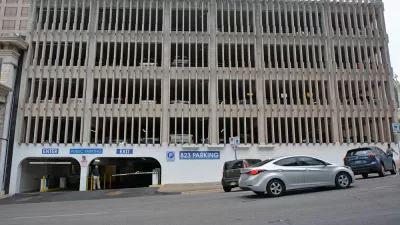City Observatory research shows that urban regions where residents drive less and rely more on other travel modes have more independent restaurants and more varied dining options. Bon appetit for walking, bicycling and public transit.

City Observatory recently used data compiled by Yelp to compute the market share of chains in the nation’s largest metro areas. Overall, about a quarter of all restaurants are part of a chain, but that fraction varies widely across metro areas. We think that a high market share of independent restaurants is likely a good indicator of a thriving and diverse food scene, and is a strong amenity for many metro areas.

We’re not sure what the driving factors are that contribute to the more robust health of independent restaurants relative to chains in some metros, but we had a hunch. Metro areas vary widely in their level of car dependence, indicated by the average number of miles driven per person per day. In the typical large metro area, that figure is about 25 miles per person per day, but is far lower in compact, transit-served metros, and noticeably higher in sprawling, car-dependent metros.
So we took U.S. DOT estimates of the number of miles driven per person per day in large metro areas and compared it with Yelp’s data on the market share of chain restaurants in those same metros.

The data show a strong positive relationship between miles driven and chain restaurant market share. Metros where people drive more have a higher fraction of chain restaurants. For example, New York, Portland, and New Orleans all have a very low share of chain restaurants (less than 20 percent), and also have very low rates of driving per capita. Places where people drive a lot (Atlanta, Charlotte and Orlando) tend to have very high proportions of chain restaurants (more than 30 percent). Overall, each additional mile driven per day is associated with an 0.6 percentage point increase in the share of chain restaurants in a metropolitan area.
We can conjecture why this might be. If people travel more by car, then it may be more important for restaurants to be visible and accessible by car, whether located along highways or in strip malls. National brands and advertising may be relatively more important to gaining consumer awareness than they are in cities where people drive less. If people spend less time driving in cities because they are more compact, or more accessible by transit, biking and walking, that may provide more niches for smaller scale independent restaurants, compared to formula-driven chains. Often times traffic levels on streets and arterials are location factors for national chains: unless a site has so many thousands of cars passing per day, they won’t consider opening a restaurant. That kind of rationale may lead to more chain restaurants in places where people drive more.
This could also be more evidence for our Green Dividend: People who drive less spend less money on cars and gasoline, and have more money to spend on food, including supporting their local independent restaurants.
Regardless of the exact reasons, the strength of this finding is striking. It suggests that if you want to have more consumer choice and more independent entrepreneurship in your local restaurant scene, you want to have a less car-dependent transportation system. Our auto dependency may be on of the things fueling the banal sameness typically associated with chains.
FULL STORY: How Driving Ruins Local Flavor

Alabama: Trump Terminates Settlements for Black Communities Harmed By Raw Sewage
Trump deemed the landmark civil rights agreement “illegal DEI and environmental justice policy.”

Study: Maui’s Plan to Convert Vacation Rentals to Long-Term Housing Could Cause Nearly $1 Billion Economic Loss
The plan would reduce visitor accommodation by 25% resulting in 1,900 jobs lost.

Planetizen Federal Action Tracker
A weekly monitor of how Trump’s orders and actions are impacting planners and planning in America.

Wind Energy on the Rise Despite Federal Policy Reversal
The Trump administration is revoking federal support for renewable energy, but demand for new projects continues unabated.

Passengers Flock to Caltrain After Electrification
The new electric trains are running faster and more reliably, leading to strong ridership growth on the Bay Area rail system.

Texas Churches Rally Behind ‘Yes in God’s Back Yard’ Legislation
Religious leaders want the state to reduce zoning regulations to streamline leasing church-owned land to housing developers.
Urban Design for Planners 1: Software Tools
This six-course series explores essential urban design concepts using open source software and equips planners with the tools they need to participate fully in the urban design process.
Planning for Universal Design
Learn the tools for implementing Universal Design in planning regulations.
Caltrans
Smith Gee Studio
Institute for Housing and Urban Development Studies (IHS)
City of Grandview
Harvard GSD Executive Education
Toledo-Lucas County Plan Commissions
Salt Lake City
NYU Wagner Graduate School of Public Service





























